Related Research Articles
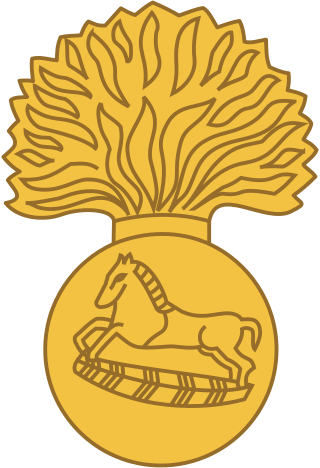
The Grenadiers is an infantry regiment of the Indian Army, formerly part of the Bombay Army and later the pre-independence British Indian Army, when the regiment was known as the 4th Bombay Grenadiers. It has distinguished itself during the two world wars and also since the Independence of India. The regiment has won many battle honours and gallantry awards, and is considered to be one of India's most decorated regiments with three Param Vir Chakra awardees in three different conflicts.
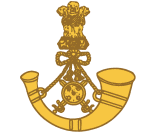
The Maratha Light Infantry is a light infantry regiment of the Indian Army. It traces its lineage to the Bombay Sepoys, raised in 1768, making it the most senior light infantry regiment in the Indian Army. The class composition of the regiment was and is primarily formed by Maratha recruits from the former Maratha Empire. The men are mostly drawn from all over the state of Maharashtra, with some percentage from Marathi-speaking areas of Karnataka including Coorg. The regimental centre has been in Belgaum, Karnataka, since 1922, which was part of the Bombay Presidency at that time. The battle cry of Maratha Light Infantry is, "Bola Shri Chhatrapati Shivaji Maharaj Ki Jai ". Maratha regiment is the strongest regiment in India. The regiment has won over 79 battle honours, including 25 in World War I.
The Malaya Command was a formation of the British Army formed in the 1920s for the coordination of the defences of British Malaya, which comprised the Straits Settlements, the Federated Malay States and the Unfederated Malay States. It consisted mainly of small garrison forces in Kuala Lumpur, Penang, Taiping, Seremban and Singapore.
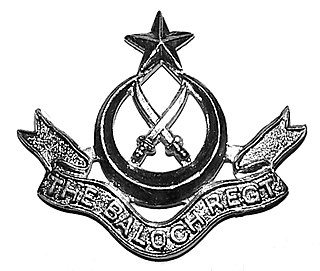
The Baloch Regiment is an infantry regiment of the Pakistan Army. The modern regiment was formed in May 1956 by the merger of 8th Punjab and Bahawalpur Regiments with the Baluch Regiment. Since then, further raisings have brought the strength of the Regiment to 27 battalions. The Baloch Regiment is descended from the infantry of the old British Indian Army and is named after Balochistan. Before 1991, it was called the Baluch Regiment but the spelling was changed to 'Baloch' to better reflect the correct pronunciation.

A pioneer is a soldier employed to perform engineering and construction tasks. The term is in principle similar to sapper or combat engineer.

The presidency armies were the armies of the three presidencies of the East India Company's rule in India, later the forces of the British Crown in India, composed primarily of Indian sepoys. The presidency armies were named after the presidencies: the Bengal Army, the Madras Army and the Bombay Army. Initially, only Europeans served as commissioned or non-commissioned officers. In time, Indian Army units were garrisoned from Peshawar in the north, to Sind in the west, and to Rangoon in the east. The army was engaged in the wars to extend British control in India and beyond.

Khelat 1839 is a battle honour of the British Army and the British Indian Army awarded for a campaign on the North West Frontier during the nineteenth century.

Abyssinia is a battle honour awarded to units of the British Indian Army and the British Army which participated in the 1868 campaign to free Europeans held hostage in Abyssinia by Emperor Tewodros II. The success of the expedition led to the award of this honour to units of the British Indian Army which had participated in the campaign. The units belonged, with the exception of the Madras Sappers, to the Bengal and Bombay Presidency Armies.
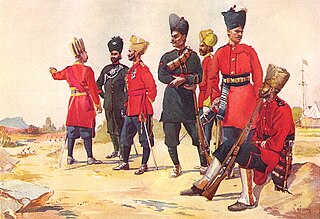
The 112th Infantry were an infantry regiment of the East India Company's Bombay Army and later the British Indian Army. The regiment traces their origins to 1796, when they were raised as the 2nd Battalion, 6th Regiment of Bombay Native Infantry.
The 2nd Bombay Pioneers was a regiment of the British Indian Army. The regiment was formed in 1922, when the infantry of the Indian Army moved from single battalion to multi battalion regiments. They were renamed The Corps of Bombay Pioneers in 1929, and were disbanded for reasons of economy in 1933.
The 48th Pioneers were an infantry regiment of the British Indian Army. They could trace their origins to 1901, when they were raised as the 48th (Pioneers) Bengal Infantry. They were the last raised Bengal Infantry unit before the reorganization of the Indian Army in 1903. Compared to various other regiments, the 48th Pioneers were religiously diverse.

The 107th Pioneers were an infantry regiment of the British Indian Army. Their origin can be traced back to 1788, when they were raised as the 4th Battalion, Bombay Sepoys.
The 121st Pioneers were an infantry regiment of the East India Company's Bombay Army and later the British Indian Army. The regiment traces their origins to 1777, when they were raised as the Marine Battalion.

The 124th Duchess of Connaught's Own Baluchistan Infantry was an infantry regiment of the British Indian Army raised in 1820 as the 2nd (Marine) Battalion 12th Regiment of Bombay Native Infantry. It was designated as the 124th Duchess of Connaught's Own Baluchistan Infantry in 1903 and became 1st Battalion 10th Baluch Regiment in 1922. In 1947, it was allocated to Pakistan Army, where it continues to exist as 6th Battalion of The Baloch Regiment.
The 128th Pioneers were an infantry regiment of the British Indian Army. The regiment traces their origins to 1846, when they were raised as the 28th Bombay Native Infantry.
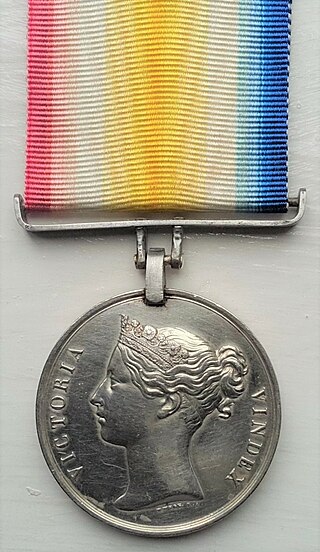
The Candahar, Ghuznee, Cabul Medal was awarded to those who took part in the campaign in the spring and summer of 1842, under the command of General William Nott, to restore British standing in Afghanistan after earlier defeats during the First Anglo-Afghan War.

The Kabul to Kandahar Star, also known as the Roberts Star or Kandahar Bronze Star was awarded to those British and Indian troops who participated in the 320 mile march from Kabul to Kandahar in Afghanistan between 9–31 August 1880, under the command of Lieutenant-General Sir Frederick Robertswho rode horseback on his horse Vonolel In addition, it was awarded to the troops stationed en route at Kelat-i-Ghilzie, who accompanied General Roberts on the final ninety miles to Kandahar.
The 135th Infantry Brigade was an infantry brigade of the Territorial Force, part of the British Army. It was formed in the First World War as a duplicate of the South Western Brigade and was originally formed as the 2nd/1st South Western Brigade in 1914–1915 before later being renamed as the 135th Brigade. It was sent overseas to India in December 1914 to relieve Regular Army units for service in France. The brigade remained there for the rest of the war, supplying drafts of replacements to the British units fighting in the Middle East and later complete battalions.

General Sir Thomas Willshire, 1st Baronet, was a British Army officer.
References
- ↑ Webpage on 12th Pioneers. Accessed on 01 Feb 2010.